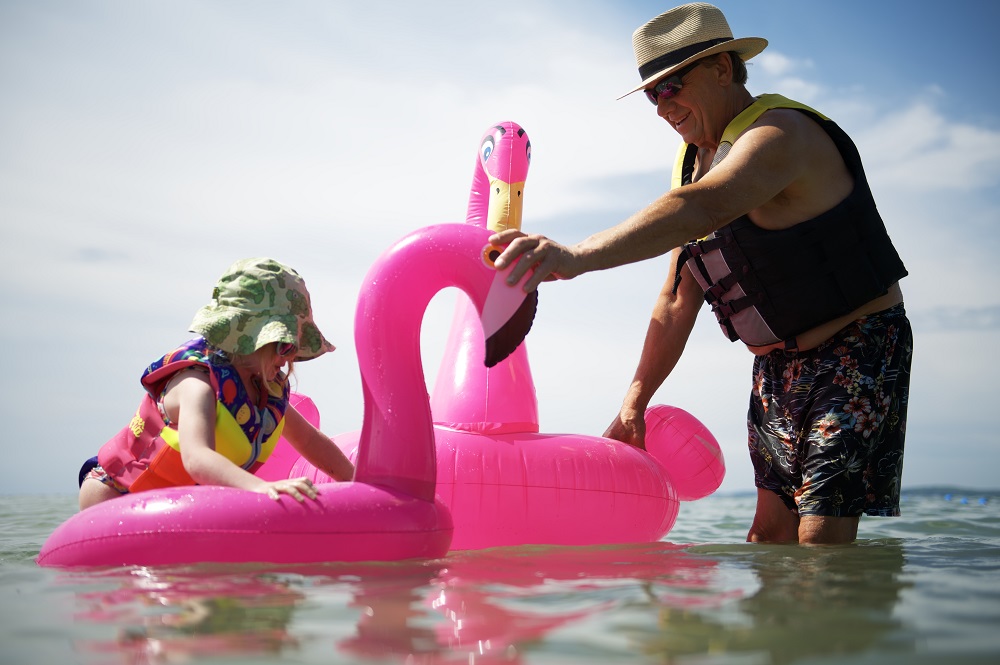The day starts out with the best intentions.
You’ve brought your inflatable flamingo (or unicorn or yellow duck or inner tube…) to your favourite beach in hopes of getting some much-needed R&R.
You wade into the water, throw the shades on, climb aboard, and lie back to soak up the sun…
… when suddenly, you’re jolted awake with the realization that you’ve drifted way out into open water!
Your swimming skills aren’t great and you didn’t wear your lifejacket or PFD, so you attempt to paddle yourself near land with your arms. But the wind’s against you.
You wave your arms, trying to get the attention of people on shore…
…until you lose your balance and slide off your slippery inflatable friend into the water…
For many park staff, this scenario is painfully familiar.
This is the danger incurred when we put too much trust in a floatie while visiting provincial parks.
Lakes are not pools (and shouldn’t be treated as such!)
Floaties may be great toys for the pool. Not so much for parks.
Pools have stairs and ladders, and the walls keep you from drifting more than a few metres.
Lakes and rivers are unpredictable, with much (MUCH) more volume and murkier waters, not to mention strong currents, waves, and breezes.
This means folks with floaties can easily drift off into unintended depths, and/or get knocked off their inflatable.
Drifting into deep or rough waters (especially on bigger waterbodies, like the Great Lakes) is a life-threatening situation, even for strong swimmers and lifejacket/PFD-wearers.
Floaties are not boats
We see a lot of floatie-lovers get lulled into a false sense of security.
Yes, they are buoyant on the water, but, no, they do not replace the stability of a boat.
Think about it:
The odds of falling off of a boat? Low (though not zero; please wear a lifejacket or PFD).
The odds of falling off of a floatie? Pretty darn high!
If capsized, your inflatable may not be easy to get back on top of, especially for non-swimmers, kids, and smaller adults.
And believe us, even for strong swimmers, attempting to get yourself back on the floatie in deep water or tough weather tires the body quickly, putting you at greater risk of exhaustion.
Additionally, floaties don’t come with steering wheels or paddles. It’s hard to keep them on course, or to propel them back to shore if you accidentally float out too far or get caught in a strong breeze or current.
And floaties aren’t tremendously durable. Have you considered what would happen if your floatie pops or starts to leak when you’re floating out in deep water?
Floatie-lovers: please put your safety first
Across the province, we’re seeing a sharp increase in floatie-related incidents.
These incidents often result in a major “all hands on deck” search party by ground, boat, and helicopter, including professional search-and-rescue crews, regular and volunteer fire departments, police services, and more.

Many of those incidents end in tragedies, despite the best efforts of some amazing first responders.
Even when everyone makes it home safe and sound, these emergency situations are costly, tying up funding and emergency personnel.
Responsible floatie behaviour
Even if you’re a “pretty good swimmer” and don’t intend on dipping a single toe in the water, you (and whoever else is floating with you) need to be prepared for the worst.
Know your location and keep an eye on the weather. Floaties are often a bad choice for Great Lake beaches, especially without a lifejacket/PFD and/or for weak swimmers. Currents and offshore breezes easily combine to pull your inflatable unicorn way past safe distance. Please make responsible choices.

Wear a lifejacket or PFD. It can save your life. Can’t swim / weak swimmer? It’s a must. And even the most experienced swimmers can still get cramped or feel exhausted if they swim when they weren’t properly prepared to be submerged in the water, especially if they inadvertently float out into open water.
If purchasing a PFD is out of the cards, you can borrow one free of charge at 70 parks across the province as part of our PARKSmart PFD Lending Program.
And before hitting the water, consider attaching a non-metallic pea-less whistle to your PFD. It’s very convenient when you need to get the attention of others in an emergency scenario.
Stay in designated swimming areas. Staying within them is the easiest way to stay close to the shoreline and out of hazardous areas.
Consider an anchor. If you have the option on a larger inflatable, an anchor is a great way to prevent drifting down the beach or deeper into water than you intended.
For caregivers, please remember: inflatables and lifejackets/PFDs are no substitute for full adult supervision. Stay within easy reach of your child in or near the water and keep BOTH EYES on them.
Again: put safety first
You and your loved ones matter to us. We want all our visitors to make it home safe and sound from a relaxing day at the park.




